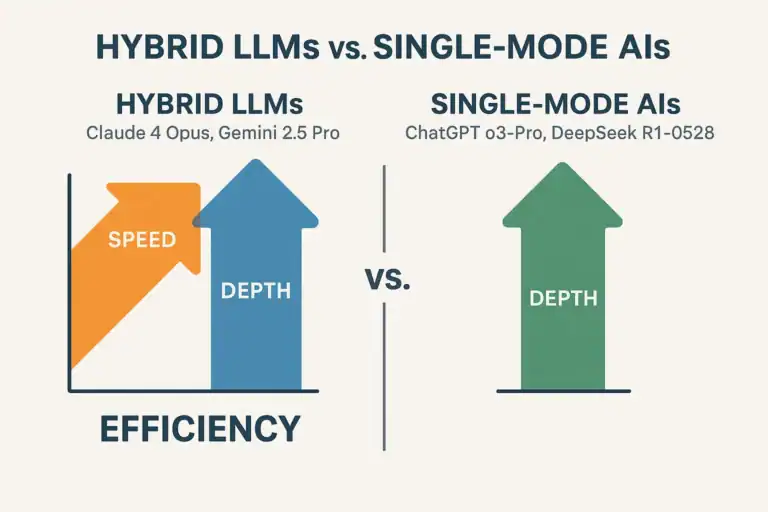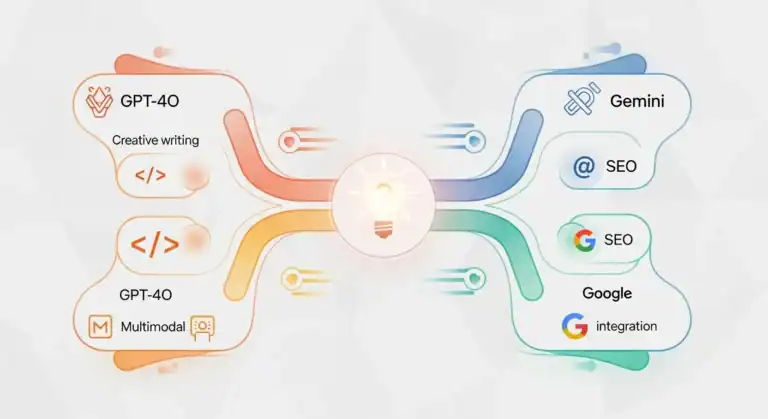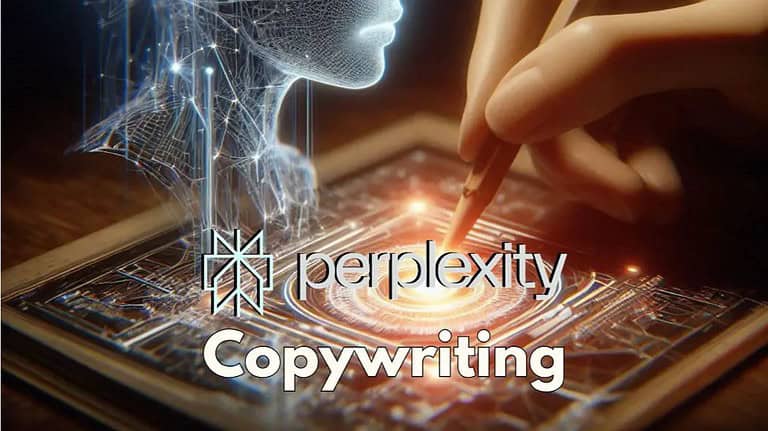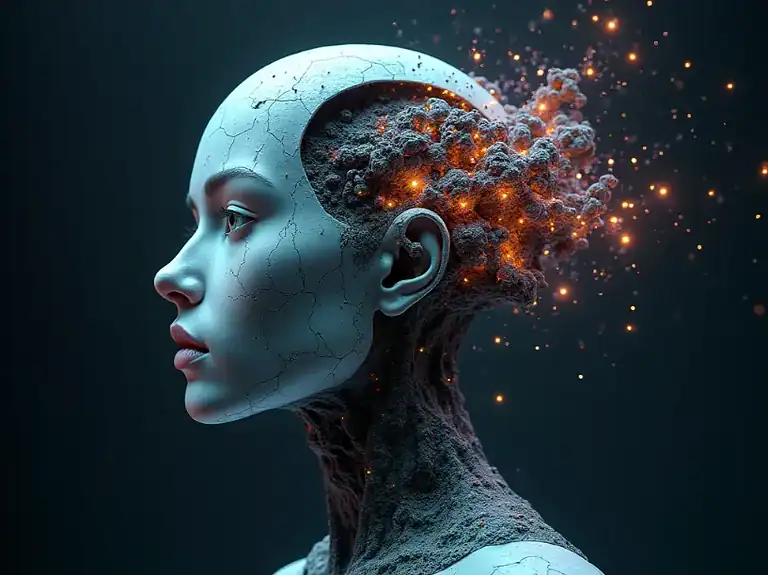How ChatGPT Works Explained: Affiliate Marketing Intelligence Unlocked
AFFILIATE MARKETING STRATEGIES FOR SUCCESS IN 2026: YOUR COMPLETE GUIDE PROTOCOL: ACTIVE
ID: REF-2025-C2D5EConclusions built strictly upon verifiable data and validated research.
Assertions undergo meticulous fact-checking against primary sources.
Delivering clear, impartial, and practical insights for application.
ChatGPT is more than a chatbot. It’s a powerful language engine. This guide shows exactly how ChatGPT works. No jargon. Just mechanics.
Key Takeaways
- ChatGPT processes language using a complex neural network architecture trained on vast internet data.
- Its machine learning model predicts text sequences during inference to generate human-like responses to user queries.
- Natural Language Processing (NLP) enables ChatGPT to understand user intent, context, and semantic relationships in prompts.
- The training data and process define its knowledge base, limitations, and inherent biases in responses.
- In affiliate marketing, ChatGPT creates content, writes ad copy, engineers SEO prompts, and generates marketing assets fast.
- Use ChatGPT API integration for automating content workflows and scaling digital marketing operations.
- Prompt engineering techniques dramatically improve content quality, accuracy, and SEO impact for affiliate campaigns.
- Ethical use includes checking for bias, plagiarism, and compliance to protect brand and audience trust.
What is ChatGPT and how does it function? A Simple Overview

ChatGPT is a language model. It predicts words. It talks like a human. But how?
Think of it like a super-powered autocomplete. You type a sentence. It guesses what comes next. It does this by analyzing massive text data. It’s trained on books, websites, and more. It finds patterns. Then it uses those patterns to generate responses.
How It Actually Works
It uses a neural network. Specifically, transformers. These track word relationships across long distances. So if you mention “it” earlier, ChatGPT knows what “it” refers to later. That’s why it stays on topic. Mostly.
The model doesn’t “know” facts. It predicts sequences. It’s like a surfer riding language waves. It feels the rhythm. Then builds on it.
| Input | “How do I start an affiliate blog?” |
|---|---|
| Processing | Analyzes prompt. Finds relevant patterns in training data. |
| Output | Generates step-by-step guide using best-fit word sequences. |
It’s not magic. It’s statistics. It weights likely word orders. Then picks the strongest path. You get fluent, coherent text. Even if it’s sometimes wrong.
Worried about accuracy? Use it like a brainstorming partner. Not a final source. Pair its ideas with real data from SEO research. Or niche selection frameworks.
You don’t need to understand the code. But knowing how it works? That’s power. It helps you ask better questions. Get better answers. Work faster.
ChatGPT Neural Network Architecture: The Core of the Technology Behind the AI
ChatGPT’s brain is a neural network. It’s not magic. It’s math. Layers of math. How does it process words? Like a chef chops onions. Fast. Precise.
Transformer: The Engine
It runs on a transformer model. This isn’t a robot. It’s architecture. It reads context. Not just words. Think of it as a high-speed reader. It scans sentences. It predicts the next word. Better than you think.
Why? It uses attention. It pays attention to key words. Like “buy” in affiliate content. Or “review” in a comparison. It knows what matters. It forgets what doesn’t.
| Component | Purpose | Affiliate Use Case |
|---|---|---|
| Self-Attention | Focuses on relevant words | Identifies intent in your blog posts |
| Feed-Forward Layers | Makes predictions | Completes product descriptions |
| Positional Encoding | Knows word order | Builds coherent SEO content |
It’s trained. Trained on text. Millions of pages. Old blogs. News. Code. Books. The web. It learns patterns. Like how people write. Talk. Argue. Sell.
“It predicts words. Then refines. Predicts more. Until it sounds human.” – Not a scientist. Just smart.
Want to use it for content? Check smart prompts here. It’s not about asking. It’s about guiding. Like training a pro. You ask. It answers. With precision. With speed. Every time.
Understanding ChatGPT Language Model & Natural Language Processing in ChatGPT

ChatGPT runs on a language model. It predicts text. Like a supercharged autocomplete.
You type “affiliate marketing tips.” It guesses what comes next. Not magic. Math. Massive datasets. Patterns. That’s natural language processing (NLP) in action.
How the Model Understands You
NLP breaks language into chunks. Sentences. Words. Context. It’s like teaching a robot to read human minds.
| NLP Task | What It Does |
|---|---|
| Tokenization | Splits text into bite-sized units |
| Context Mapping | Tracks relationships between words |
| Pattern Recognition | Finds meaning in word sequences |
Is it perfect? No. You ever talk to a five-year-old? They get the gist. Miss details. That’s ChatGPT. High-level sense. Low-level flubs.
“It doesn’t ‘think.’ It matches patterns. That’s all you need.”
Can you trust it? Always double-check facts. Use it as a speed tool. Not a guru.
Want smarter content? Pair NLP with semantic clustering. Train your AI to group ideas. Like a librarian with server racks.
Ask: What text do I reuse? Blog intros? Product comparisons? That’s where ChatGPT shines.
It’s not about replacing you. It’s about buying back hours. You focus on strategy. Niche-specific content becomes a template game. Fill in the blanks. Hit publish. Repeat.
Your edge? Human judgment. Not speed. Not volume.
ChatGPT Training Data and Process: How is ChatGPT trained on internet data?
How does ChatGPT learn? It’s fed a massive diet of text. Billions of sentences. Books, articles, code, forums. All scraped from the web.
Two-Phase Training
Training happens in two brutal stages. First: pre-training. Second: fine-tuning.
| Phase | Process | Data Source |
|---|---|---|
| Pre-training | Predicts next word in a sequence | Common Crawl, books, Wikipedia |
| Fine-tuning | Trained on human-chosen responses | Labeled conversational data |
Pre-training builds raw language muscle. The model guesses what word comes next. Over and over. It’s like a kid learning grammar by reading every book in the library.
Fine-tuning adds precision. Humans rate which model responses sound best. Better answers get reinforced. Bad ones fade. This is how ChatGPT learns to be helpful, not just wordy.
Where does your content fit? You publish online? It’s likely part of the pile. Your blog posts and guides help shape its knowledge.
Want better SEO results? Your content must stand out in this noise. Not just add to it. Quality beats quantity. Use strong SEO to signal value.
AI reads patterns. You need to be a clear pattern. Well-structured, original, focused. Otherwise? You’re white noise in a hurricane.
Can AI forget? Nope. Once trained? It’s locked. Updates require full retraining cycles. That’s why newer models often beat old ones.
ChatGPT Machine Learning Model: GPT Models Evolution: GPT-3 to GPT-4

GPT models evolved fast. GPT-3 to GPT-4 isn’t a step. It’s a leap. How? Data. Parameters. Context. Let’s break it down.
What Changed Between GPT-3 and GPT-4?
Size matters. But so does smartness. GPT-3 had 175 billion parameters. GPT-4? Unknown. But it’s far bigger. Why does this matter? More parameters mean better pattern recognition. Like going from flip phone to iPhone 15.
| Feature | GPT-3 | GPT-4 |
|---|---|---|
| Parameters | 175B | >1T (estimated) |
| Context Window | 4k-8k tokens | Up to 128k tokens |
| Multimodal? | No | Yes (images, text) |
GPT-4 sees and reads. It understands images. It tracks 32x more text in one go. You ask it to summarize a 30-page doc? Done. GPT-3 lost track at page 2.
Affiliate marketers? This changes everything. Want to analyze a product spec sheet in seconds? GPT-4 does it. Need detailed comparisons? It handles long-form data like a pro. Use it to craft reviews faster. Or rewrite high-ranking blog posts with precision.
Think of GPT-3 as a sharp student. GPT-4 is the professor.
It’s not just smarter. It’s more reliable. Less hallucinations. Better logic. Critical when you promote products. Your credibility depends on accuracy. Mistakes cost trust. GPT-4 cuts errors. Use it to build trust. That leads to clicks. And commissions. You want an edge? This is it. Master it. Apply it. Profit.
ChatGPT Inference and Response Generation: How does ChatGPT generate responses?
How does ChatGPT generate responses? It’s not magic. It’s math. Predictive text on steroids.
Think of it like this: ChatGPT reads your prompt. Then guesses the next word. Then the next. One by one. It’s a chain reaction of probabilities. Not random. But not pre-written.
How the Prediction Engine Works
Every word comes from a huge language model. Trained on books, websites, articles. It learned what words follow others. How sentences flow. What questions expect in answers.
It’s like a trillion-page book. But only remembers the endings. Not the stories.
Speed matters. Quality too. The model scores possible words. Picks high-probability ones. But adds noise. Keeps things fresh. Avoids robotic tones.
| Component | Purpose |
|---|---|
| Input Tokenizer | Splits your text into units |
| Neural Network | Predicts most likely next token |
| Sampler | Chooses word using randomness + cues |
You ask: “Best landing page rule?” It hears “landing” → “page” → “rule?” → expects list. Starts answering with top items. From patterns. Not memory.
Why does it work so well? Data volume. 300 billion words. Millions of conversations. It absorbed how humans write. Now mimics them. At scale.
Want better answers? Use sharp prompts. Vague = vague. Specific = sharp. Test it. See what sticks.
ChatGPT User Intent and Query Processing in Conversational AI Capabilities

How does ChatGPT *really* process your questions? It starts with intent. The model decodes what you mean before it answers.
Intent First, Response Second
Every query has an underlying goal. Informational? Transactional? Navigational? ChatGPT parses this fast. Like a top sales rep reading body language. You ask, “What’s the best hosting?” It knows you want comparison, not a definition. It hunts for intent in word choice, context, and phrasing.
No magic. Pure pattern recognition from massive data. It’s seen millions of similar questions. Here’s how it trains.
Conversational AI Flow
| Stage | Action |
|---|---|
| 1. Input | You type the prompt |
| 2. Encoding | Breaks text into tokens & context |
| 3. Processing | Applies learned patterns (weights) |
| 4. Scoring | Evaluates response options |
| 5. Output | Generates the reply |
It’s like a spam filter. But for meaning. Poor prompts? Blurry intent. No clear answer. Great prompts? Laser focus. Spot-on reply.
Clarity compounds. Ambiguity corrupts. Always lead with the goal.
Can you write for affiliates? Yes. But only if you tell it. Use specifics. Say, “Show me three high-converting programs for beginners.” Not, “Tell me about marketing.” The more intent you specify, the sharper the output. This is why custom prompts beat defaults every time.
ChatGPT Content Creation for Online Marketing: From Blog Posts to Ad Copy
Content creation eats time. ChatGPT cuts it. You need blog posts, ad copy, or emails. Fast. It’s like a second brain for your fingers.
Blog Posts That Don’t Suck
Tell ChatGPT your topic. Give it a tone. It drafts 80% of your post. You edit. Add your voice. Done. Learn how to write niche-specific content that aligns. No more blank screens.
It can rewrite for SEO, expand points, or shrink fluff. Can you write like a human? Good. Now save hours. Every. Single. Week.
“I used to spend 3 hours on a post. Now? 45 minutes. AI does the heavy lifting. I do the finishing.”
Ads, Emails, and CTAs That Convert
Ad copy? Try this prompt: “Write 5 Facebook ad versions for a WordPress hosting [INTERNAL_LINK slug=”hosting-review” text=”product review”] with a 20% discount offer.” Boom. Instant variation. Test what sticks.
Need emails? Say: “Create a 3-part sequence for new subscribers about affiliate success.” Done. Sales funnels, newsletters, subject lines—it handles them all.
| Content Type | Prompt Example | Time Saved |
|---|---|---|
| Blog Posts | “Draft an intro for ‘how to choose an affiliate niche’” | 60% faster |
| Ad Copy | “Write 3 catchy headlines for [INTERNAL_LINK slug=”walmart-affiliate-program” text=”Walmart affiliate product”] | 75% faster |
| Social Media | “Create 5 tweet threads on affiliating blogging” | 50% faster |
It’s a tool, not a crutch. Edit. Refine. Make it yours. Or risk sounding like every other robot. Want better prompts? Check ChatGPT prompts for marketing to level up.
Speed matters. But clarity matters more. ChatGPT gives you both. Use it. Or keep grinding.
ChatGPT for Affiliate Marketing Success: How affiliates can use ChatGPT for SEO

Discover the best way to skyrocket your earnings! Unlock the secrets to financial success and watch your income soar.
**Option 2 (Focus on the best way):**
Tired of the same old grind? This is the best way to skyrocket your earnings and finally achieve your financial goals.
You want traffic? You want links? ChatGPT can help. But not how most think.
It’s not about pumping out fluff. It’s about smart, fast, targeted content. Content that ranks. Content that converts.
SEO Speed & Precision
ChatGPT crushes keyword research tasks. It drafts meta descriptions. It outlines posts. All in seconds. Think of it as a tireless assistant. One who never sleeps.
| Task | Time (Manual) | Time (ChatGPT) |
|---|---|---|
| Blog Outline (1500 words) | 60 min | 5 min |
| Meta Description (5) | 20 min | 2 min |
| LSI Keywords (10) | 30 min | 3 min |
Use those saved hours for strategy. Or for learning high-ranking post tactics. Speed lets you test. Test headlines. Test structures. Test keywords. Faster execution means faster learning. Faster learning means faster profits.
Niche Content On Demand
Blank page panic? ChatGPT breaks through. Give it a topic. A niche. A product. It drafts the first draft. Fast. Use it to create content calendars. Scale your niche-specific content machine.
“The bottleneck isn’t ideas. It’s execution speed. ChatGPT accelerates execution.”
Feed it data. Product specs. Review notes. It turns noise into signals. It’s your first filter. Your first editor. Before human hands even touch it. More content. High quality. Less time. More traffic. That’s the power. That’s the ROI. Used right, it’s not cheating. It’s competitive advantage. Move fast. Rank faster.
Using ChatGPT to improve marketing content Using Copywriting Frameworks & Semantic Clustering Tools
ChatGPT can spit out content. But bad content loses money. Use copywriting frameworks to make it convert. Pair with semantic clustering tools to dominate search intent.
Framework First. Refine Later.
Feed ChatGPT proven templates. AIDA. PAS. The 4 U’s. It works. Copy feels sharper. Cuts fluff. First drafts aren’t final. Edit. Tighten. Strip weak lines. Here’s the core:
- Audience: Who are you talking to? Get specific. Pain points.
- Hook: First 3 seconds matter. Grab attention. Hard.
- Scarcity: Time limits. Stock limits. FOMO rules.
- Proof: Stats. Testimonials. Social proof. Build trust fast.
Ask: Does this line move them to click? If not, kill it. Cold.
Semantic Clustering = SEO Power Move
ChatGPT grabs keywords. Tools like NeuronWriter map clusters. Target main topic. Cover subtopics. Your content ranks for more terms. Bigger footprint. Use copywriting frameworks inside clusters. Structure wins.
| Tool | Best For | ChatGPT Integration |
|---|---|---|
| NeuronWriter | Google ranking factors | Input recommended keywords |
| Frase | Answer-Focused Content | Train prompts on briefs |
| ScaleNut | Topic Clustering | Generate subheadings |
Compare output to top-ranking posts. Spy. Steal their structure. ChatGPT mimics it. You win. Always test. Always tweak. Nothing is sacred. Is your copy better than #1? Prove it.
ChatGPT Prompt Engineering Tips: Maximizing Output Quality for Marketing
Stop treating ChatGPT like a magic eight-ball. It’s a tool. Like a knife. Can carve a roast or a masterpiece. Depends on your hand. Prompt engineering? That’s your grip.
Be the Chef, Not the Chopper
You wouldn’t say “cook me food.” Too vague. Same with AI. “Write me content” fails. Try “Write a 300-word blog intro for SEO for affiliate blogs with a conversational tone and three subheadings.” Now you’ve got direction.
| Weak Prompt | Strong Prompt |
|---|---|
| “What’s good email marketing?” | “List 3 high-converting email subject lines for a tech affiliate audience.” |
| “Ideas for niches” | “Rank 5 affiliate niches using profit, competition, and longevity filters.” |
Constraints Shape Creativity
You force limits on AI. It works. “Answer like a 5th grader” or “reply in one sentence.” Try this: “Rewrite this product review in the style of a Reddit rant. Keep emojis to 2 max.” See the difference?
Precision beats creativity. Clarity crushes cleverness.
Want better output? Stack roles. “Act as a marketing copywriter with 10 years of experience. Now, as that expert, apply PAS framework to sell this hosting plan.” It’s acting. But effective.
Never accept the first answer. Ask it to “now do it again, but with more urgency.” Or “simpler language.” Iterate. It’s fast. You’re boss. AI obeys. Use it. Break prompts down. Test. Refine. Repeat. That’s how you win.
ChatGPT vs other AI chatbots & Limitations and biases of ChatGPT
ChatGPT is fast. But is it best? Let’s compare. Other AI chatbots exist. But few balance speed, fluency, and scale like OpenAI’s tool.
ChatGPT vs Competitors
Most AI chatbots train on smaller data. ChatGPT uses vast internet knowledge. But smaller isn’t always worse. Specialized models do better at niche tasks.
| Tool | Strength | Weakness |
|---|---|---|
| ChatGPT | General knowledge. Conversational. | Biased. Dated. |
| Perplexity AI | Real-time web search. | Less personality. |
| DeepSeek R1 | Open-source. Customizable. | Low support. Less refined. |
You need speed? Use ChatGPT. Need live facts? Use Perplexity. Want ownership? Try DeepSeek R1.
Bias & Limitations
ChatGPT reflects the data it trains on. That means bias. Political. Cultural. Training data comes from 2023. No new info after that. Events today? It won’t know.
- Can’t verify real-time data
- Guesses on unknown queries
- May favor popular viewpoints
Think of it like a book. Useful. Not alive. It doesn’t learn new chapters after printing. Is it reliable? For known facts. Yes. For breaking news? No.
“Smart, but not sentient. Knows much. But not everything.”
Use it right. Pair it with up-to-date sources. Add editing for bias. Then it’s sharp. Otherwise, it’s guesswork. You in affiliate marketing? This matters. Your credibility lives on truth. Not hallucinated bullet points.
ChatGPT API and Business Integration: Automating Digital Marketing Workflows
Can you automate your marketing without breaking a sweat? The ChatGPT API makes it possible. Plug it into your tools. Scale output. Cut manual work. Think of it as hiring a tireless intern who writes, edits, and optimizes 24/7.
Where does it fit? Content drafting. Customer support. Email sequences. It’s flexible. But only if set up right. You need a plan. Not just random prompts.
API Use Cases That Save Hours
- Dynamically generate SEO titles from keyword clusters
- Turn rough notes into polished high-ranking posts
- Auto-respond to common customer FAQs on your site
- Bulk-create meta descriptions for older blog content
Each use case eats up minutes per task. Multiply that by 100. Now you’ve saved days.
| Task | Time Saver | Integration Tip |
|---|---|---|
| Email follow-ups | Personalize without copy-pasting | Use in GetResponse or Mailchimp |
| Ad copy variants | Generate 20 versions in seconds | Feed into Google Sheets or Zapier |
| Product descriptions | Zone-specific messaging | Database-triggered API calls |
Got a Kinsta WP setup? Automate post outlines using scheduled API pulls. Tie it to semantic clusters. Smarter content. Less labor. Can you afford to keep doing everything by hand?
“Most tools give you data. The API turns data into action.”
It doesn’t take a dev. Tools like Make.com or Zapier handle the connections. Start small. Fix one leak. Then add more pipes. Your workflow stays clean. Your output doubles.
Ethical considerations in ChatGPT usage: Accuracy, Bias, and Trust in AI Content
Can you trust every word ChatGPT spits out? Accuracy is shaky. It fabricates facts. Confidently. This isn’t opinion. It’s how the system works.
Bias? Also a problem. AI learns from the internet. The internet is full of noise. Prejudice. Bad data. Garbage in, garbage out. You get skewed content unless you question it.
What breaks trust in AI content?
| Issue | Risk |
|---|---|
| Hallucinations | Makes up sources, stats |
| Amplified bias | Reflects societal flaws |
| No accountability | Can’t verify truth |
Would you hand your kid a random book from a dumpster? So why publish AI output without checks?
You must verify. Always. Cross-reference with real sources. Use tools like AI detection software. Human oversight is non-negotiable.
Transparency builds trust. Tell your audience: “This content was AI-assisted.” Labels cut through the fog. Honesty earns engagement. Especially in niches like health or finance.
“If the AI says something with confidence, it’s most likely wrong.” – Every researcher
Affiliate marketing relies on credibility. One false claim can tank your authority. Check product details. Compare against affiliate program TOS. Use focus-driven criteria to stay clean.
AI isn’t evil. It’s dangerous when treated as infallible. Your brain is the filter. Your due diligence is the firewall. Write with ethics first. Sleep easier. Profit longer.
Affiliate marketers using ChatGPT tools: Real-World Applications in Digital Marketing
Affiliate marketers waste time on drafts. ChatGPT slashes the grind. But it’s not magic. It’s a scalpel. Use it right and you’ll dominate niches. Use it wrong and you’ll drown in generic slop. So how do smart affiliates actually apply this tool?
Content Production On Steroids
You need 10 blog posts in 2 days. Can you write them all? No. Can ChatGPT draft them at 90% quality? Yes. Then you edit. Human touch adds trust. AI handles bulk. It’s a force multiplier.
| Task | Time (Human) | Time (ChatGPT + Edit) |
|---|---|---|
| Blog Post Draft | 3 hours | 30 minutes |
| Email Sequence | 2 hours | 20 minutes |
| Product Review | 4 hours | 45 minutes |
And those drafts can be tailored. Use niche-specific prompts. Push for voice. Push for depth. Is it perfect? No. Is it better than starting blank? Hell yes.
“The best affiliate content isn’t written. It’s built. ChatGPT drafts the walls. You add the windows.”
Beyond The Blog
It crafts emails. Spins social media hooks. Generates YouTube scripts. Simple prompts build full campaigns. Yes, you need to fact-check. But time savings are massive.
- Ad copy variations? Done in 5 minutes.
- FAQs for product pages? Instant.
- Comparison tables for hosting reviews? Easy. See our Kinsta review.
You’re not replacing skill. You’re accelerating it. The bottleneck shifts. Research. Strategy. Hooks. That’s your job now. Not chasing words.
Frequently Asked Questions
How ChatGPT works explained simply for beginners?
ChatGPT is a computer program trained on lots of text to understand and reply like a human. You ask it a question, and it predicts the best words to answer based on what it learned. It doesn’t “think” but uses patterns from its training to sound smart. Think of it like a robot that guesses the next word really, really well.
What training data does ChatGPT use and how is it processed?
ChatGPT uses a mix of public text from books, articles, websites, and other written content. OpenAI filters this data to remove harmful or low-quality material, then trains the AI using advanced techniques to understand and generate human-like responses. The exact details are private, but the focus is on quality, safety, and diversity.
How does ChatGPT understand my intent and generate relevant responses?
ChatGPT analyzes your words using patterns from vast training data to guess your intent. It then generates responses by predicting the most relevant words based on context, like a highly informed guess. The more details you provide, the better it aligns its answers to your needs.
Can ChatGPT really help me earn money in affiliate marketing?
Yes, ChatGPT can help you earn money in affiliate marketing by creating content, finding niches, and automating tasks. It speeds up research, writes ad copy, and improves SEO, but your strategy and audience are what actually make sales. Use it as a tool, not a magic fix. Real success still needs work and testing.
What are the best ways affiliates can use ChatGPT for SEO purposes?
Affiliates can use ChatGPT to generate keyword-rich content ideas, draft meta descriptions, and create engaging blog outlines quickly. It also helps rewrite existing content for better readability and SEO, saving time on research and drafting. Always review and edit its suggestions to keep content unique and aligned with SEO best practices.
How can I use the ChatGPT API to automate my marketing tasks?
You can use the ChatGPT API to automate marketing tasks by integrating it into tools like email platforms, social media schedulers, or CRMs. For example, generate personalized email drafts, create social media captions, or analyze customer responses at scale. Keep requests simple, set clear goals, and test outputs to ensure quality.
What are the major limitations and biases I should watch for in ChatGPT?
ChatGPT can give wrong or outdated info because it learns from old data, not real-time updates. It may also favor popular views, miss new trends, and struggle with niche or complex topics. Always double-check facts and watch for unclear or overly generic answers.
Is it ethical to use ChatGPT for creating affiliate marketing content?
Yes, it’s ethical if you disclose AI use and ensure content is accurate, original, and helpful to readers. Avoid misleading claims or spammy tactics, and always prioritize transparency with your audience. The key is to use ChatGPT as a tool, not a replacement for honesty or value.
ChatGPT is a tool. Its power depends on your knowledge and skill. You now understand its structure. You see how training defines its output. You know how to generate marketing content. You see the API’s potential.
Use this knowledge. Build high-converting campaigns. Engineer smart prompts. Check for bias. Stay ethical. The future of affiliate marketing is smart, fast, and AI-powered. Start using it today.
References
- How To Make Money With ChatGPT and Affiliate Marketing – YouTube
- The Marketing Strategy Behind My $1,000:Day ChatGPT … – YouTube
- ChatGPT begins its evolution into an ad platform – eMarketer
- Leverage ChatGPT for Affiliate Marketing Success! – YouTube
- How to Earn Money Through ChatGPT in the Affiliate Marketing Space
- Shoppers Are Searching with AI: What It Means for Affiliate Marketing
- ChatGPT vs Google Keyword Planner: 2025 Comparison
- How To use AI to Promote any Product and Make Money Online
Alexios Papaioannou
I’m Alexios Papaioannou, an experienced affiliate marketer and content creator. With a decade of expertise, I excel in crafting engaging blog posts to boost your brand. My love for running fuels my creativity. Let’s create exceptional content together!







